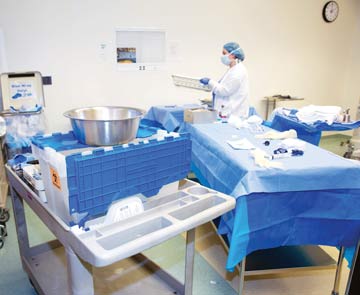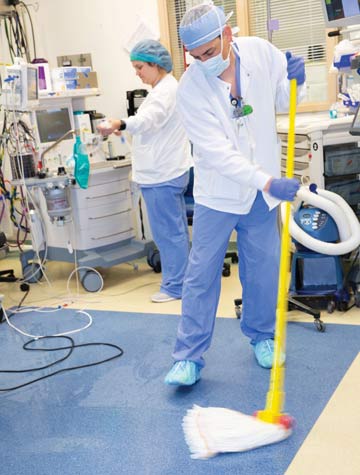Six Surface Disinfection Concepts
The puzzle of superior surface disinfection is never solved....
This website uses cookies. to enhance your browsing experience, serve personalized ads or content, and analyze our traffic. By clicking “Accept & Close”, you consent to our use of cookies. Read our Privacy Policy to learn more.
By: Mike Morsch
Published: 6/19/2019
You never want to sacrifice patient safety in your quest to start the next case as soon as possible. Here's a collection of tips to speed room turnover without jeopardizing your level of care.
Let's start with a few creative ways to let environmental services know that a room is down and that it needs to be cleaned. There are beepers, overhead paging systems, red magnets and even electronic boards that flash a "final stitch" symbol.
Look at what's actually going on, both the larger and smaller problems, and identify issues that are causing any member of the team to be idle before beginning a task, like waiting for housekeeping to clean the room. At Geisinger, they observed from the time the patient was wheeled out to when the next patient was wheeled in. What was everybody doing? Were they staying busy?
"Look at how the room is set up and how it is cleaned," says Ms. Soloski. "Are your nurses opening their trays and counting everything before the patient is wheeled in or is there a time where they could wheel the patient in and still be setting up their table?"
There are some instances where the scrub tech can continue to set up the table and complete the count after the patient is wheeled into the room. This eliminates some of anesthesia's waiting time because they can get the patient positioned and under anesthesia while the final setup and count is taking place.

Does your turnover team empty the trash or remove dirty linens while patients are still in the OR? Not only is this practice distracting to the providers caring for the patient, but it's also the perfect setting for cross-contamination.
"I've seen nurses gathering dirty instruments in carts to take to central sterile while the anesthesia tech is setting up for the next patient in the still-dirty room," says Libby Chinnes, RN, BSN, CIC, FAPIC, president of IC Solutions in Mount Pleasant, S.C. "Even if surgeons are pressuring your turnover team to work quickly, they shouldn't enter the room until the patient is wheeled out of the OR."
Your policy should state that environmental cleaning should occur after each patient, but not until the patient has left the area — whether it be the OR, procedure room, pre-op or PACU — per the 2018 edition of AORN Guidelines for Perioperative Practice, says Ms. Chinnes.
Yes, don't start until cleaning until the patient leaves the room, but you can start cleaning up before housekeeping gets there. At Geisinger, they found that the nurse and scrub tech would leave the room at the end of a case and wait for housekeeping to arrive before they started cleaning.
"If 4 rooms come down and you have only 2 housekeepers available to clean, you can only do one person per room at that point," says Ms. Soloski. "And you have 2 rooms sitting idle until someone can finish one and go to the next. That adds to the turnover time."
They asked scrub techs to begin to bag up all the trash and put it outside the room if housekeeping is not present at the room upon the patient's departure. And once the RN has taken the patient to PACU, they ask her to return to the room and help the scrub tech start the clean-up and breakdown. This lets the cleaning process begin while housekeeping is tied up in another room.
Have the case carts ready to go in advance. You don't want your nurses running around between cases to pick up soft goods that aren't on the case cart.
"Prior to the start of the day, the OR personnel should look at all their case supplies for the day to include instruments and equipment," says Ms. Norman. "This helps organize the day so that they are not looking for instruments and equipment in between cases."
Ms. Norman says that gathering your items in between each case slows down the turnover time. "Organization and communication are the keys to turnovers," she says.
There are two different processes for case carts at the 2 Geisinger campuses. At one campus, the central sterile department is divided into two parts, one of which does the decontamination and puts the trays together; the other that picks the case carts. At the other campus, soft goods get picked by the supply chain and then the trays for the first two cases of the day in each room get put on the carts the night before by the nursing staff. Additional staff then comes in later in the morning to work on the carts for rest of the cases throughout the day.

One area that made the biggest impact on reducing turnover times at Riverside County Regional Medical Center (RCRMC) in Moreno Valley, Calif., was changing a serial flow pattern to one of parallel processing. As an example, the prior workflow included that after one procedure was finished, the surgeon, anesthesiologist and a nurse would converge on the next patient for the next procedure.
"We changed that to having a member of the nursing, surgical and anesthesia teams seeing the next patient while the prior surgical procedure was ongoing," said David Ninan, DO, medical director and chairman of the anesthesia department at RCRMC. "That way, at the conclusion of the prior procedure, the team would only need to verify important elements, which in turn reduced the time needed for processing the patient."
Another idea to streamline the flow would be to have a PACU staff member come directly to the OR to get the patient. A handoff could be given from RN to RN while the patient is waking up.
"Eliminating the circulator from having to go to PACU would leave one more body in the room to assist with turnover," says Jason Bainbridge, RN, BSN, MBA, patient care manager of the surgery center at Regina Hospital in Hastings, Minn. "It also allows the PACU staff to interact more with OR and a PACU staff member is one more person to help with transferring a patient."
In addition to making their jobs easier, you can get a lot of buy-in from your staff with rewards and recognition. At Geisinger, they set turnover time goals. They take an average of what the turnover time is per service line and then take a 10% reduction in that number and that's the goal for that service line.
They then post the room turnover times daily on the communication huddle boards at the OR control desk, so that the teams can see how they're doing. The top performing teams that exceed their goal for the service line that they're in that day receive gift cards for the cafeteria and coffee stand inside the hospital. Their names are also posted on the huddle board for all to see.
"It gets them engaged in what we're doing," says Ms. Soloski, whose teams at Geisinger cut the turnover time from an average of 38 minutes to an average of 35 minutes across all service lines. "Who doesn't love a little bit of healthy competition? And who doesn't love a free cup of coffee?"
To keep your turnover times crisp not just today, but for months to come, you must also address your organizational culture. This means investing in human factors such as the initial buy-in of key team members and soliciting frequent feedback with positive reinforcement, says Dr. Ninan.
Remember that everybody on the team plays a role in reducing turnover times. It's usually an evolving process, as facilities continue to look for ways big and small to trim turnover times without sacrificing quality care. OSM
The puzzle of superior surface disinfection is never solved....
Boston Children’s Hospital is renowned for its exemplary care on many fronts, including surgery....
Manual cleaning done properly is effective for eradicating microorganisms....